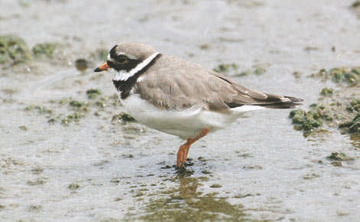
Ringed Plover © David Platt
Large numbers of Ringed Plovers pass through in spring and autumn on their journeys between Greenland and Africa, and both the Mersey and Dee estuaries exceed the national threshold for passage of 300 birds, but far fewer winter in the county and no site is of conservation importance for the species. Most of those the wintering birds are of British stock, but there might be some immigrants from continental European breeding sites along the coasts of the Wadden Sea and Baltic. They find their food by watching for movement at or near the sand surface, taking primarily marine worms, crustaceans and molluscs and they tend to keep towards the top of the beach, away from the tide-edge.
The species is Amber Listed because of its decline in winter numbers nationally, and those in Cheshire and Wirral have certainly dropped over the last thirty years. At the beginning of the 20th century the Ringed Plover was a plentiful winter resident, both in the Dee and Mersey, and Coward (1910) had seen ‘large flocks consorting with Dunlins and Redshanks in December and January, and in February the numbers are often very great’. Without any numbers quoted, it is impossible to know what these adjectives mean, although they sound much larger than the present figures, as does Bell’s assessment of ‘common winter resident at the coast’, although he later says ‘regular in small numbers in the estuaries throughout the winter’ (Bell 1962).
By the start of the Birds of Estuaries Enquiry (now WeBS) in 1970 there were almost 300 Ringed Plovers wintering on the Dee but they were present only in single figures on the Mersey, if at all. The Dee figure of 386 in January 1975 was unusually high, but by the mid-1980s numbers on the Dee had dwindled to less than one hundred in most winter months, rising again by the early 1990s to average around 150, a level maintained, with yearly fluctuations, to the present, although most WeBS counts during this Atlas period were low, with only the odd winter month exceeding 100 birds.
Otherwise, the only three figure counts during this Atlas came from the northwest Wirral coast, with 120 at Hilbre in 2005/ 06, and 100 there in 2006/ 07, and separate counts of 150 birds in 2004/ 05 at West Kirby (SJ28D) and Hoylake shore (SJ29A), with 100 at West Kirby in 2005/ 06. The only other count over sixty was of 90 birds at Frodsham Marsh in 2004/ 05. Half of the Atlas records were in small groups of ten or fewer. Ringed Plovers were found in only three sites away from tidal areas. Two birds were reported in SJ68R, and two or three birds returned early to breeding sites in the Neumann’s Flash area (SJ67S/ W).
Sponsored by Mike Allsopp

